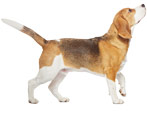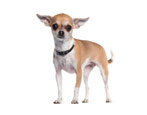Any dog breeder should know that even if his pet is the most good-natured creature, the muzzle should always be at hand. If you don’t put it on your pet when you walk on the street, then there are public places where you can’t do without a muzzle. These can be parks and playgrounds where children walk or are, public transport or entertainment facilities (clubs, stadiums, cafes, etc.). It is also necessary if you have an aggressive dog or she likes to pick up dirty objects on the street, lick surfaces, and, of course, for visits to the veterinarian.
Many at the mention of this accessory are crooked, knowing that no dog is happy to walk in a muzzle, but you need to treat this item as the rest of the elements of "dog uniforms" - a collar, leash, costumes.
You will not have any problems with training if you started training your pet as a puppy. But even if the moment is missed, still nothing is lost - stable training and patience will help put a muzzle on the dog.

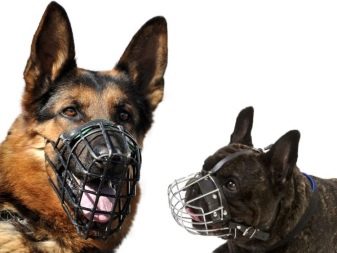
Choose a muzzle
It is very important to identify a few points to consider when buying:
- the muzzle should be the size of the jaw of the pet, not dangle and not crush, but free enough to open the mouth;
- the dog should not be stuffy;
- the holes between the straps should give the dog the opportunity to stick his tongue out;
- the muzzle can be made of plastic, metal, leather, nylon (the choice depends on the breed of the dog, its size and on the situation in which you want to put on a muzzle);
- depending on the destination, they select the appropriate model (for example, in the heat of a walk in the park it makes no sense to "pack" the dog in a solid muzzle, the "basket" model will fit much better - it is free and allows you to breathe easily).
Remember thermoregulation is very important. Dogs should freely stick out their tongues and open their mouths, because oral regulation provides thermoregulation. Dogs, unlike humans, do not have so many sweat glands.
It is strictly forbidden to tighten the jaws of the pet to the pet - this can even lead to death, because the animal simply cannot regulate the normal body temperature with a closed jaw and can get a heat stroke leading to death.

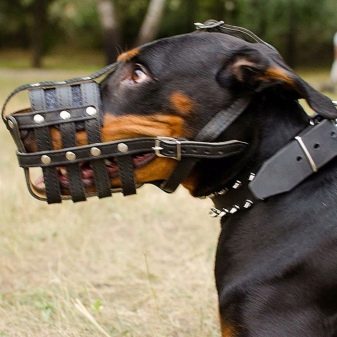
Muzzles are necessary in order to ensure the safety of those around you, and in some cases yourself. It is especially necessary at the reception of a veterinarian, and, in general, in the provision of any medical care, even if you yourself act as a veterinarian. Sometimes your pet, experiencing pain or experiencing trauma, may inadvertently bite you when you are trying to help.
To go to the veterinarian, we recommend that you purchase fabric muzzle, which can be bought at any pet store with veterinary clinics. There is a huge selection and you can always try on different models to find the perfect one.
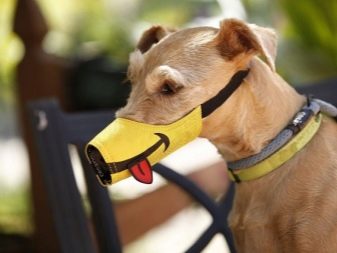

Put a muzzle on the pet
What age is ideal for learning? Most often, a muzzle begins to be worn on five-month-old puppies. But even if you didn’t start at that age, but decided to train an adult dog, then there’s no difficulty because the training scheme is focused on both puppies and adult dogs.
- The first step in the training will be a simple acquaintance with the accessory. Put it in front of the pet (do not let it play with a muzzle or scratch it), let it smell. Try to explain that everything is good and this is a useful subject. The animal will certainly catch your positive attitude and good intonation. Show that the item is not a threat. Praise the dog for the way it welcomes the novelty.
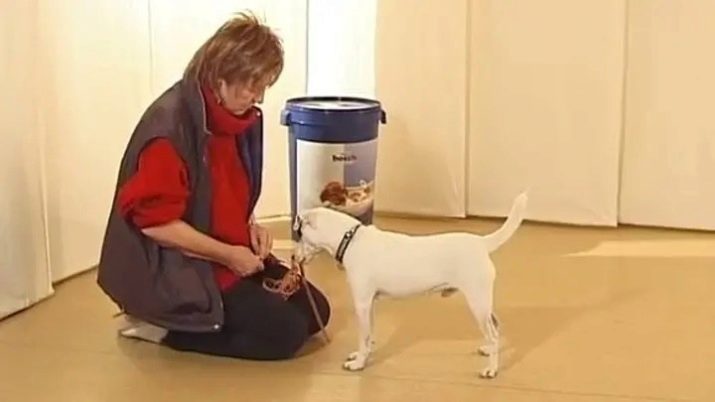
- Now you can do the "bait". Take something edible from your pet’s favorite treats and put in the muzzle so that the animal will have to stick its muzzle inside to get the treat. You need to try feeding through the basket. Do not rush to fasten the muzzle and rejoice if the animal has obeyed. For now, the dog should just get food and crawl out freely - otherwise the method will create an erroneous association that it is a trap and the dog will not make contact anymore. “Turn” the trick several times, creating an associative series.
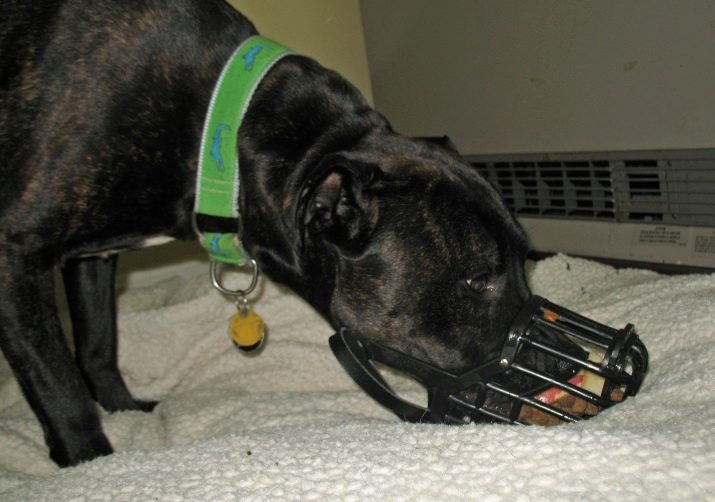
- Now you need to create a longer time interval between the receipt of treats. Wait a couple of seconds and unclench your hand only after that, to let the dog know that you need to stay inside the muzzle for a treat. Be sure to praise when the pet is obeying.

- If you managed to hold the animal up to ten seconds, you can try to fasten the straps and fasten the muzzle. Do not skimp on praise - this is something completely new to your friend, and the fear is obvious. Let the dog feel the full power of your support. For the dog to have positive expectations, put on a muzzle before feeding.

- Do not get angry when the dog is trying hard to remove the muzzle. Learn to distract - whistle, calling for a game, throw a ball or a toy. Always have encouraging goodies on hand. This time is a real test of patience for both you and the dog. She will constantly try to get rid of the accessory, which is understandable, because this is an artificial construction, the use of which cannot be explained to the dog. But be persistent and do not indulge when the animal asks to remove the muzzle. Create good associations with the dog in the dog - let it be a harbinger of walks or games.
Be sure to encourage the dog treats, if you see that he has been in the muzzle for a long time and does not tear it.

- If you can’t train your pet to muzzle on your own, and without it it’s impossible to do without it due to various circumstances, do not hesitate to turn to professionals and people for help, who have already gone this way, successfully trained their pets and are ready to share knowledge. Dog breeders love to arrange meetings where they willingly share their experiences. Communicating with each other, dog lovers get answers to many questions, which in the future helps to avoid mistakes in raising pets.
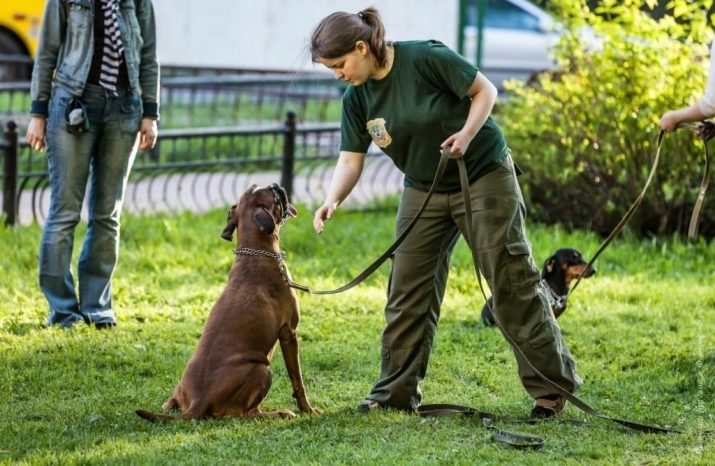
Useful Tips
- Do not jump from stage to stage. Do not miss important points when you see progress. Repeated teams, patience, and building the right associations are the key to success.
- Do not remove the muzzle by indulging the dog when she herself is trying to get rid of him. This will make her understand that you are following her commands, and not vice versa, and then she will endlessly try to free herself, and hint that you unfasten the straps.
- Do not muzzle an animal before events or actions that it does not like (maybe this is a vet appointment or bathing). The dog will associate the muzzle only with the negative, and the training process will be very painful.
As you can see, if you make very little effort and be patient, there is nothing complicated in accustoming to ammunition. And if everything is done accurately and in stages, your four-legged favorite will not perceive the muzzle as an enemy object, but, on the contrary, will understand that this is a signal of something pleasant.
Praise your friend and show that nothing bad will happen, that if you agree, he will have a pleasant surprise or a long-awaited walk.

Create the right, warm atmosphere and reap the benefits of your efforts with a smile.
Next, watch a video with tips on how to properly train a dog to a muzzle.





